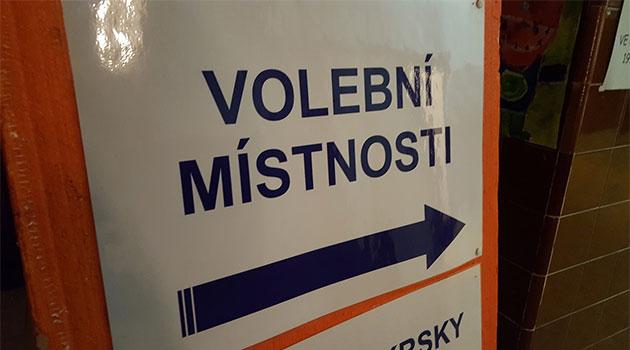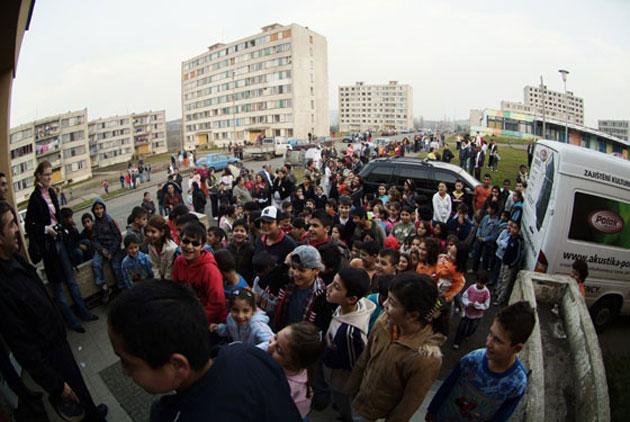Czech Republic: Low turnout in socially excluded localities, but ANO, Communists and Okamura scored there

In socially excluded localities predominantly inhabited by Romani people very few voters went to the polls. The lowest voter participation was at the Chanov housing estate in the town of Most, and voters did not turn out much in the Předlice quarter either.
In precincts where such localities can be found, the ANO movement of Andrej Babiš mostly won, with Tomio Okamura’s “Freedom and Direct Democracy” (SPD) party winning votes also. Below is an overview of the results in selected localities.
Chanov
Most’s Chanov housing estate regularly produces very interesting electoral outcomes. This year, however, there was no miracle and no surprises.
Just 34 voters cast ballots, a participation rate of 4.41 %. The Communist Party of Bohemia and Moravia won 66.66 % of the vote there, with the Czech Social Democratic Party (ČSSD) coming in second at 21.21 %, two votes cast for the “Realists”, and one vote each cast for ANO and STAN.
The script of the previous two elections – Romani voters casting ballots en masse for the same politicians – did not repeat itself. In 2013 the candidate who scored significant success there was Karel Novotný, who ran in 18th place and “miraculously” got 145 preferential votes in Chanov out of 170 total for the ČSSD.
Novotný paid his “obeisance” to those Romani voters by comparing all Romani people to “jellyfish” because they are “good for nothing and poisonous”, a remark he posted to Facebook just before this year’s elections. He earned exactly one preferential vote yesterday.
In the past, Romani people from Chanov had also similarly voted for another candidate who was actually against them, Bronislav Schwarz. In 2010, as the leader of the candidate list for the “Sovereignty” party led by Jana Bobošíková, he won 100 % of the preferential votes cast there.
In the 2013 elections to the lower house, when he ran for the ANO movement, he earned no preferential votes. This year he ran for the “Citizens’ Rights Party”, which seated nobody, and he received no preferential votes.
Předlice
Romani people did not vote much here either, and their turnout of 7.91 % in precinct 1014, which covers the streets of Beneše Lounského, Řeháčkova or Prostřední, is one of the lowest participation rates in the entire country. Of the 71 votes cast, 16 (22.85 %) were cast for ANO, while the Communists and the Green Party got 12 votes each (17.14 %) – during the 2013 elections the participation was higher, with 167 people casting ballots.
Mojžíř
According to public broadcaster Czech Radio (the Radiožurnál station) there was vote-buying at the Mojžíř housing estate. Inhabitants there said they were paid CZK 200 [EUR 8] per ballot.
According to testimony by local residents, the vote-buying was organized by a Czech man and a Romani man. “It was already filled out. A Czech and one Rom were walking around,” was how one resident described the distribution of ballots in a parking lot.
One candidate circled on such a ballot shown to Radiožurnál was the Mayor of Krupka, Zdeněk Matouš, while another was Krupka’s Vice-Mayor, Karel Rouček. Mojžíř voters ended up giving 32.35 % of the precinct results to ANO and 22.05 % of the results to the second-place ČSSD.
Matouš and Rouček won 31 of the 45 preferential votes cast for the ČSSD overall. Okamura’s SPD got 8.33 %, behind the Communists with 13.72 %.
Krupka
At the Maršov housing estate in Krupka, where according to estimates by the Czech Government Agency for Social Inclusion about 70 % of the residents are Romani, voter turnout was around 25 %. That is similar to the 2013 results.
The ANO movement won comfortably (34.4 %) ahead of Okamura’s SPD (17.5 %). Third place went to ODS (9.8 %), ahead of the Communists (9.2 %).
Obrnice
Approximately 2 500 people live in Obrnice, and according to qualified estimates more than 1 000 of them are Romani. In the socially excluded locality that is colloquially termed the “Big Housing Estate”, the ANO movement won with 31.01 % ahead of the ODS party of Mayor Drahomíra Miklošová (25.46 %).
Third place went to the Communists at 13.72 %. Turnout was 19.62 %.
Brno
In the electoral precincts where the neighborhood of Francouzská and Bratislavská Streets is located, i.e., the so-called “Brno Bronx”, voter turnout was between 20 – 27 %. In precinct 20009, where the Museum of Romani Culture is located, the winner was ANO (21.87 %), second place went to the Pirates (15.62 %) and the ODS and SPD each got 12.5%.
Duchcov
In Duchcov, which has previously been a staging ground for anti-Romani demonstrations and has been a bastion of the Workers’ Social Justice Party (DSSS), the ANO movement won with 42.07 %. Unlike 2013, when the DSSS won 18.45 % in precinct no. 1, this time they failed, getting just 1.82 % locally and just 3.87 % nationally, while second place went to the SPD (14.86 %) and third place to the Communists (10.41 %).
Varnsdorf
The ANO movement scored a significant success in Varnsdorf, especially at the Kovářská housing estate, where the residents of municipally-owned residential hotels relocated in 2011 after anti-Romani marches where held in the town. About 700 people live there now, and those voting were 41.86 % for ANO, 18.02 % for SPD and 7.26 % for the Communists.
Ostrava
Rather interesting results came from the voting in the Přívoz quarter of Ostrava. Electoral turnout was about 17 %.
In precinct 8001, Okamura’s SPD party came first at 27.61 %, ahead of ANO (20.95 %). In precinct 8002 those political groups traded places.
Ralsko
In this electoral precinct that includes the excluded localities of Náhlov and Ploužnice the ANO movement eked out a first place finish (31.34 %) over the Communists (30.55 %), with SPD a distant third at 11.9 %. Turnout was 32.65 %.
